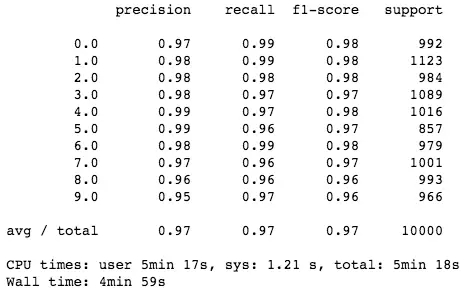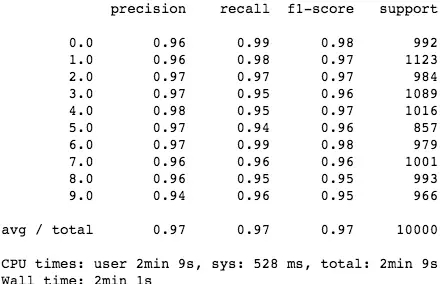K 近邻算法,简称 K-NN。在如今深度学习盛行的时代,这个经典的机器学习算法经常被轻视。本篇教程将带你使用 Scikit-Learn 构建 K 近邻算法,并应用于 MNIST 数据集。然后,作者将带你构建自己的 K-NN 算法,开发出比 Scikit-Learn K-NN 更准更快的算法。
一、K 近邻分类模型
K 近邻算法是一种容易实现的监督机器学习算法,并且其分类性能的鲁棒性还不错。K-NN ***的优点之一就是它是一个惰性算法,即该模型无须训练就可以对数据进行分类,而不像其他需要训练的 ML 算法,如 SVM、回归和多层感知机。
K-NN 如何工作
为了对给定的数据点 p 进行分类,K-NN 模型首先使用某个距离度量将 p 与其数据库中其它点进行比较。
距离度量就是类似欧几里得距离之类的标准,以两个点为输入并返回这两个点之间距离的简单函数。
因此,可以假设距离较小的两个点比距离较大的两个点相似度更高。这是 K-NN 的核心思想。
该过程将返回一个无序数组,其中数组中的每一项都表示 p 与模型数据库中 n 个数据点之间的距离。所以返回数组的大小为 n。
K 近邻的 K 的含义是:k 是一个任意值(通常在 3-11 之间),表示模型在对 p 分类时应该考虑多少个最相似的点。然后模型将记录这 k 个最相似的值,并使用投票算法来决定 p 属于哪一类,如下图所示。
上图中的 K-NN 模型的 k 值为 3,箭头指向的中心点为 p,算法将对这个点进行分类。
如你所见,圆圈中的三个点是与 p 最接近或最相似的三个点。因此,使用简单的投票算法,p 将被归为「白色」,因为白色在 k 个最相似值中占大多数。
酷炫!但令人惊讶的是,这个简单的算法可以在某些情况下实现不俗的结果,并且可以应用于各种各样的问题,我们将在下面介绍。
二、在 Scikit-Learn 中实现 K-NN 算法用来分类 MNIST 图像
1. 数据
对于这个例子,我们将使用常见的 MNIST 数据集。MNIST 数据集是机器学习中最常用的数据集之一,因为它很容易实现,而且是验证我们模型的可靠方法。
MNIST 是一组包含 70,000 个手写数字 0-9 的数据集。任意两个手写数字都不相同,有些可能很难正确分类。
2. 算法
我们从 Scikit-Learn 的 Python 库的 KNeighborsClassifier() 函数入手。这个函数有很多参数,但在这个例子中我们只需用少量几个参数。具体来说,我们只会传递 n_neighbors 参数的值(就是 k 值啦)。
weights 参数给出了模型使用的投票算法的类型,其中默认值是 uniform。这意味着在对 p 进行分类时,k 个点中的每一个的权重都一样。algorithm 参数也将使用默认值 auto,因为我们希望 Scikit-Learn 自动找到对 MNIST 数据进行分类的***算法。
以下是一个用 Scikit-Learn 构建 K-NN 分类器的 Jupyter Notebook:Scikit-Learn 实现的用于 MNIST 的 K 近邻算法
Notebook 地址:https://gist.github.com/samgrassi01/82d0e5f89daac3e65531a6ef497cc129#file-skl-knn-ipynb
我们通过导入所需的库直接开始。
- In [1]:
- import numpy as np
- from sklearn import datasets, model_selection
- from sklearn.neighbors import KNeighborsClassifier
- from sklearn.metrics import classification_report
- mnist = datasets.fetch_mldata('MNIST original')
- data, target = mnist.data, mnist.target
- # make sure everything was correctly imported
- data.shape, target.shape
- Out[1]:
- ((70000, 784), (70000,))
(1) 构建数据集
我们通过制作不同的数据集来构建 K-NN 模型。我们将创建一个可以获取特定大小数据集、返回数据集大小的函数。
- In [2]:
- # make an array of indices the size of MNIST to use for making the data sets.
- # This array is in random order, so we can use it to scramble up the MNIST data
- indx = np.random.choice(len(target), 70000, replace=False)
- # method for building datasets to test with
- def mk_dataset(size):
- """makes a dataset of size "size", and returns that datasets images and targets
- This is used to make the dataset that will be stored by a model and used in
- experimenting with different stored dataset sizes
- """
- train_img = [data[i] for i in indx[:size]]
- train_img = np.array(train_img)
- train_target = [target[i] for i in indx[:size]]
- train_target = np.array(train_target)
不错。现在我们将使用这个函数来构建两个不同大小的数据集,来看看模型在不同数据量上的分类性能怎么样。
提示:制作较小的数据集时,你仍然可以进行分类,但模型毕竟少了一些数据,这可能会导致分类错误。
- In [3]:
- # lets make a dataset of size 50,000, meaning the model will have 50,000 data points to compare each
- # new point it is to classify to
- fifty_x, fifty_y = mk_dataset(50000)
- fifty_x.shape, fifty_y.shape
- Out[3]:
- ((50000, 784), (50000,))
- In [4]:
- # lets make one more of size 20,000 and see how classification accuracy decreases when we use that one
- twenty_x, twenty_y = mk_dataset(20000)
- twenty_x.shape, twenty_y.shape
- Out[4]:
- ((20000, 784), (20000,))
注意这些数据是如何为模型匹配标签的。模型需要这些标签来理解每一个点代表什么,因此可以把我们要分类的点放在一个特定的类中,而不是说「这是与待分类点最相似的类」。
现在我们将构建一个大小为 10000 的测试集。
- In [5]:
- # build model testing dataset
- test_img = [data[i] for i in indx[60000:70000]]
- test_img1 = np.array(test_img)
- test_target = [target[i] for i in indx[60000:70000]]
- test_target1 = np.array(test_target)
- test_img1.shape, test_target1.shape
- Out[5]:
- ((10000, 784), (10000,))
不错!现在我们已经完成了所有的数据处理,可以开始搭建 K-NN 模型了!
(2) 构建模型
我们首先将 Scikit-Learn K-NN 模型放在函数中,以便可以轻松调用它并对其进行调整。
- In [6]:
- def skl_knn(k, test_data, test_target, stored_data, stored_target):
- """k: number of neighbors to use in classication
- test_data: the data/targets used to test the classifier
- stored_data: the data/targets used to classify the test_data
- """
- classifier = KNeighborsClassifier(n_neighbors=k)
- classifier.fit(stored_data, stored_target)
- y_pred = classifier.predict(test_data)
- print(classification_report(test_target, y_pred))
(3) 测试
现在我们看看这个模型在两个不同的测试集上的运行效果。
- In [7]:
- %%time
- # stored data set size of 50,000
- skl_knn(5, test_img1, test_target1, fifty_x, fifty_y)
- In [8]:
- %%time
- # stored data set size of 20,000
- skl_knn(5, test_img1, test_target1, twenty_x, twenty_y)
可以的!我们的模型与人眼识别差不多!如你所见,当模型有更多的数据可以使用时(50,000 而不是 20,000 个点),它的性能会更好。更加引人注目的是,它非常简单,并且能以人类水平来获取不同图像之间的复杂关系。更多的细节分析请访问这个 GitHub repo:
https://github.com/samgrassi01/Cosine-Similarity-Classifier。
厉害了!我们使用 Scikit-Learn 构建了一个非常简单的 K 近邻模型,该模型在 MNIST 数据集上表现非凡。
不足之处?分类这些点需要很长时间(两个数据集分别耗时 8 分钟和 4 分钟),讽刺的是,K-NN 仍然是最快的分类方法之一。我们必须有一个更快的方法。
三、构建一个更快的模型
大多数 K-NN 模型使用欧几里德距离或曼哈顿距离作为 go-to 距离度量。这些指标非常简单,而且在各种各样的情况中都表现不错。
还有一个很少用到的距离标准度量是余弦相似度。余弦相似度通常不是 go-to 距离度量标准,这是因为它违反了三角不等式,而且对负数无效。但是,余弦相似度对于 MNIST 来说很***。它速度快、算法简单,而且比 MNIST 中应用其他距离度量的准确率稍高一些。
但是,为了得到***性能,我们需要自己编写 K-NN 模型。然后,我们应该能得到比 Scikit-Learn 模型更高的性能,甚至能得到更高的准确度。让我们看看以下建立的 K-NN 模型的 Notebook 吧:
构建一个更快的 KNN 分类器
Notebook 地址:
https://gist.github.com/samgrassi01/15a1fe53dcde8813eed9367b103676b2#file-cos-knn-ipynb
在这个 notebook 中,我们将构建一个简单的 K-NN 模型,该模型使用余弦相似度作为距离度量对 MNIST 图像进行分类,试图找到更快或更加准确的模型。
首先,需要导入所需的库,然后构建与 Scikit-Learn K-NN notebook 相同的数据集。
- In [1]:
- import numpy as np
- import heapq
- from collections import Counter
- from sklearn.metrics.pairwise import cosine_similarity
- from sklearn import datasets, model_selection
- from sklearn.metrics import classification_report
- mnist = datasets.fetch_mldata('MNIST original')
- data, target = mnist.data, mnist.target
- # make sure everything was correctly imported
- data.shape, target.shape
- Out[1]:
- ((70000, 784), (70000,))
使用与 Scikit-Learn K-NN notebook 相同的方法,设置完全相同的数据集。
- In [2]:
- # make an array of indices the size of MNIST to use for making the data sets.
- # This array is in random order, so we can use it to scramble up the MNIST data
- indx = np.random.choice(len(target), 70000, replace=False)
- # method for building datasets to test with
- def mk_dataset(size):
- """makes a dataset of size "size", and returns that datasets images and targets
- This is used to make the dataset that will be stored by a model and used in
- experimenting with different stored dataset sizes
- """
- train_img = [data[i] for i in indx[:size]]
- train_img = np.array(train_img)
- train_target = [target[i] for i in indx[:size]]
- train_target = np.array(train_target)
- return train_img, train_target
- In [3]:
- # lets make a dataset of size 50,000, meaning the model will have 50,000 data points to compare each
- # new point it is to classify to
- fifty_x, fifty_y = mk_dataset(50000)
- fifty_x.shape, fifty_y.shape
- Out[3]:
- ((50000, 784), (50000,))
- In [4]:
- # lets make one more of size 20,000 and see how classification accuracy decreases when we use that one
- twenty_x, twenty_y = mk_dataset(20000)
- twenty_x.shape, twenty_y.shape
- Out[4]:
- ((20000, 784), (20000,))
- In [5]:
- # build model testing dataset
- test_img = [data[i] for i in indx[60000:70000]]
- test_img1 = np.array(test_img)
- test_target = [target[i] for i in indx[60000:70000]]
- test_target1 = np.array(test_target)
- test_img1.shape, test_target1.shape
- Out[5]:
- ((10000, 784), (10000,))
1. . 构建模型
下面,我们创建函数 cos_knn(),作为用于 MNIST 数据集的分类器。你可以利用函数的注释了解其工作原理。
- In [6]:
- def cos_knn(k, test_data, test_target, stored_data, stored_target):
- """k: number of neighbors to use for voting
- test_data: a set of unobserved images to classify
- test_target: the labels for the test_data (for calculating accuracy)
- stored_data: the images already observed and available to the model
- stored_target: labels for stored_data
- """
- # find cosine similarity for every point in test_data between every other point in stored_data
- cosim = cosine_similarity(test_data, stored_data)
- # get top k indices of images in stored_data that are most similar to any given test_data point
- top = [(heapq.nlargest((k), range(len(i)), i.take)) for i in cosim]
- # convert indices to numbers using stored target values
- top = [[stored_target[j] for j in i[:k]] for i in top]
- # vote, and return prediction for every image in test_data
- pred = [max(set(i), key=i.count) for i in top]
- pred = np.array(pred)
- # print table giving classifier accuracy using test_target
- print(classification_report(test_target, pred))
2. 测试模型
现在,就像 Scikit-Learn K-NN 模型一样,我们对 cos_knn() 模型在两个数据集上分别测试,并看看它的性能如何。
- In [7]:
- %%time
- # stored data set size of 50,000
- cos_knn(5, test_img1, test_target1, fifty_x, fifty_y)
- In [8]:
- %%time
- # stored data set size of 20,000
- cos_knn(5, test_img1, test_target1, twenty_x, twenty_y)
太棒了!余弦相似度模型性能超过了 Scikit-Learn K-NN!值得一提的是,该模型的分类速度和准确率都优于 Scikit-Learn K-NN(其中速度获得了很大提升),而模型却非常简单!
为了进一步分析模型的工作原理,同时了解该模型为何在许多不同情况下比 Scikit-Learn K-NN 模型要性能更优,请参阅这个 GitHub repo:
https://github.com/samgrassi01/Cosine-Similarity-Classifier。
正如 notebook 所示,该 K-NN 模型在分类速度和准确率方面都胜过了 Scikit-Learn K-NN,其中速度获得了大幅提升,而在一个数据集上的准确率提高了 1%。既然如此,我们可以在实践中继续使用这个模型了。
四、结论
首先,我们知道了 K-NN 的工作机制,以及如何轻松地实现它。但最重要的是,我们发现,始终考虑需要解决的问题以及解决问题的工具非常重要。有时候,在解决问题的过程中,***花一些时间来实践——当然,也需要建立自己的模型。正如 notebook 中所展示的那样,它可以带来极大的益处:我们第二个专有模型获得了 1.5 - 2 倍的加速,节省了很多时间。
原文链接:
https://towardsdatascience.com/building-improving-a-k-nearest-neighbors-algorithm-in-python-3b6b5320d2f8
【本文是51CTO专栏机构“机器之心”的原创译文,微信公众号“机器之心( id: almosthuman2014)”】








































